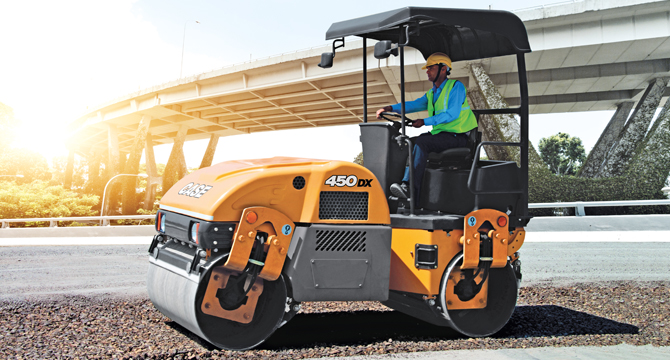
At CASE, we prioritize machine and operator safety in our manufacturing process.

CASE India is a premium brand, offering ‘Best-in-Class’ Compactors, Motor Graders and top line machines available in India. In an exclusive interview to CONSTRUCTION OPPORTUNITIES, SATENDRA TIWARI, EXECUTIVE DIRECTOR – OPERATIONS, CASE CONSTRUCTION EQUIPMENT speaks about the latest trends, his company’s offerings, future outlook and a lot more.
Give us an overview of the Compaction equipment industry in India, latest trends and market dynamics.
India’s compaction equipment sector is experiencing a robust surge, driven by ambitious infrastructure projects and the rising demand for road construction and maintenance machinery. Recent sales data shows an impressive 18% year-on-year growth in the first quarter of FY24. This growth is largely due to increased government infrastructure spending, aimed at completing projects. Moreover, the government’s strategy to allocate most of the funds within this calendar year is expected to further boost sales in the coming quarters. This upward trend underscores the sector’s resilience and its vital role in advancing India’s urbanization and modernization initiatives.
Notably, the Indian government has launched transformative initiatives like the Bharatmala Project, which focuses on the comprehensive development and improvement of the national highway network. The compaction equipment sector is essential in shaping these infrastructure landscapes, leading to increased road and highway construction across various regions. Additionally, the National Infrastructure Pipeline (NIP) is set to expedite the development and modernization of road and highway networks. With transportation as a critical priority, the NIP has allocated a substantial $1.4 trillion for infrastructure investments by 2025.
Tell us about the range of Compaction equipment offered by you, in terms of types, capacities and applications.
Our equipment, such as the CASE 952EX Soil Compactor and 1107EX PD Soil Compactor, employs a vibratory compaction method. This technique uses eccentric weights rotating at high speeds to create vibrations in the compactor’s drum. These vibrations are transmitted to the soil or asphalt surface, causing effective densification and compaction. The vibrating drum generates both vertical and horizontal forces, working together to achieve optimal compaction. The vertical force compresses soil particles, reducing voids and increasing material density, while the horizontal force levels the surface and ensures even compaction. Using vibratory compaction, our equipment can achieve greater compaction depths and superior results compared to static compactors.
The vibrations penetrate and compact a wide range of soil types, including granular and cohesive soils. This method also enhances the compaction of asphalt layers, ensuring a smooth and durable road surface. Additionally, our compactors offer adjustable vibration frequencies and amplitudes, allowing operators to customize the compaction process to specific soil or asphalt conditions. This flexibility ensures optimal compaction and improved productivity across various construction sites.
Factors such as safety, operator comfort, ease of operations are crucial. What are the steps undertaken by you for providing the same?
At CASE, we prioritize machine and operator safety in our manufacturing process. Our equipment are designed with user-friendly controls, safe cabins offering unobstructed visibility, and sophisticated consoles for seamless operation. This focus on ease of use contributes to a secure working environment. Our cutting-edge telematics further enhance safety through remote diagnosis and monitoring. Our motor graders feature a unique trip meter on the operator’s dashboard, which continuously monitors fuel consumption, hours of operation, and operating temperatures. This feature not only enhances safety but also contributes to efficient machine management.
Beyond safety, our machines are versatile, making them highly productive and cost-effective. This multifaceted approach ensures that CASE products not only meet the highest safety standards but also deliver optimal performance in various operating environments.
What sort of government policies or measures will foster growth for the compaction equipment industry?
To help the compaction equipment industry grow, the government can take several steps. Increasing investment in infrastructure projects, like road construction and urban development, is crucial for boosting demand. Offering incentives for research and development, such as grants and tax breaks, will speed up technological improvements, making equipment more efficient and innovative. The forecasted growth trajectory of the Compaction Equipment market from 2024 to 2031 underscores its resilience and potential amidst evolving economic landscapes. With a robust CAGR of 15.62%, the market is poised to expand significantly, driven by increasing investments in research and development, as well as advancements in technology. By 2031, reaching a valuation of 6.22 billion marks a transformative leap from 2.6 billion in 2024, reflecting strong demand dynamics and market maturation.
Strengthening the ‘Make in India’ program can encourage local manufacturing, reducing the need for imports and helping the industry grow. Investing in smart city projects will also increase the demand for advanced construction equipment. According to the Indian Construction Equipment Manufacturers’ Association (ICEMA), the industry sold 1,07,779 units in the previous fiscal year. This growth is a direct result of the government’s infrastructure-led growth agenda and the pre-election push for projects in the pipeline. Allocating funds for rural infrastructure projects, like road construction and maintenance, will further expand the market for compaction equipment in less developed areas. These measures, along with the governments focus on infrastructure and urbanization, will create a favorable environment for the industry’s growth and technological progress. With continuous investments in infrastructure and urban development, the industry is poised for further expansion, offering tremendous opportunities for innovation and technological advancements.
Future outlook on the industry and from a company perspective.
The future outlook for the compaction equipment industry is promising, with significant growth potential on the horizon. From a company perspective, this industry offers substantial opportunities for expansion and innovation, particularly for those investing in advanced technology and efficient equipment.
Strategically, companies should prioritize enhancing their research capabilities, forming partnerships to drive technological advancements, and expanding their product offerings to meet diverse customer needs. Emphasizing sustainability and compliance with environmental regulations will be crucial as the industry shifts towards eco-friendlier practices.
Moreover, the Indian Construction Equipment Manufacturers Association (ICEMA) envisions a transformative path towards 2030 for India’s construction equipment industry. Aiming to enhance the competitiveness and positioning of the Indian CE sector, ICEMA is focused on creating an ecosystem that attracts investments, scales operations, and boosts overall industry competitiveness. In line with the Atmanirbhar Bharat vision, ICEMA aims to increase indigenization and reduce reliance on imports. By advocating for supportive policies, addressing gaps in the manufacturing ecosystem, introducing skill development initiatives, and enhancing governance of emission norms, ICEMA is paving the way for the Indian CE industry to emerge as a global leader. Collaborative efforts with industry leaders and stakeholders are set to propel the industry towards achieving its ambitious Vision Plan 2030, shaping a robust and world-class infrastructure landscape in India.













